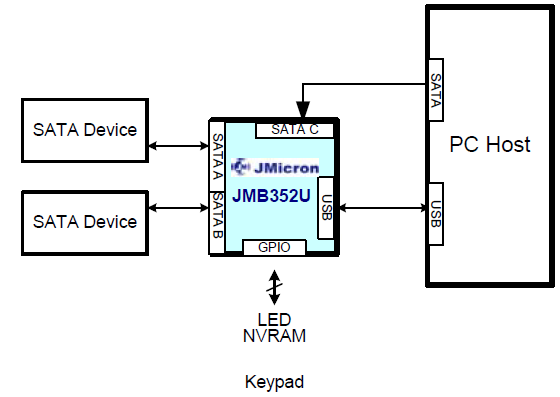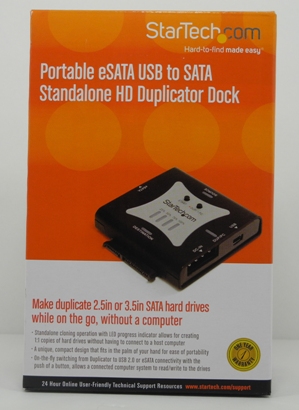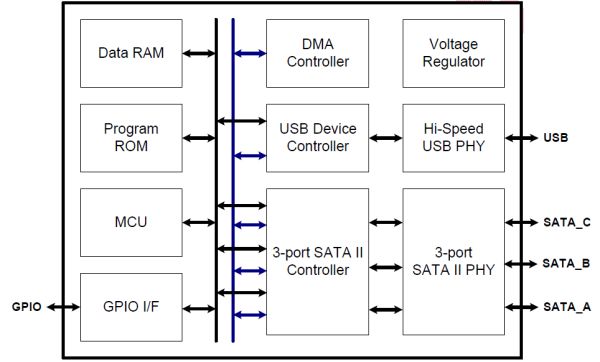StarTech.com Portable SATA Duplicator & USB / eSATA Dock Review
by Ganesh T S on September 6, 2011 6:50 PM EST- Posted in
- Gadgets
Once in a while, we encounter a gadget performing a niche, yet handy function. A month or so back, we received a pitch for a palm sized portable SATA duplicator (with eSATA / USB dock) from StarTech.com with the model number SATDUPUE.
Before going into the details, a summary of the product's features is given below:
- Standalone sector-by-sector SATA drive copying with LED progress indicator
- Push-button switching between Duplicator mode and Docking Station mode
- Compact, pocket-sized form factor
- SATA II compliant eSATA host interface and USB 2.0 compliant host interface
- Support for both 2.5" and 3.5" SATA drives
- Support for hot-swap and plug-and-play operations
This product caught my eye because there are not too many players in the niche SATA duplicator market. While it is possible to use a PC to make a sectory by sector clone of the hard disk, there are many situations where one might want to avoid the hassle of finding a PC and installing the appropriate software on it. PC-independent SATA duplicators might find use are:
- Forensic investigators wanting to back up hard drive evidence
- Computer technicians at customer sites without access to a desktop PC
- Computer users wanting quick and painless backups
In addition to StarTech.com, some of the contenders in the casual (2-bay) SATA duplicator market are Aluratek, Kanguru, Bytecc etc. A quick search seems to reveal that almost all of these are based on the JMicron JMB352 class of SATA bridge chips.
Since 'StarTech.com portable SATA duplicator / dock' is too lengthy to type, I will refer to it with its model name (SATDUPUE) in the rest of the review. The JMicron JMB352U used in the SATDUPUE is a USB 2.0 / SATA II combo to dual SATA II port multiplier (1 to 2) bridge. The bridge chip also has a 8051 microcontroller embedded.
The SATDUPUE uses the above bridge chip in the following configuration.

Note that the PC host and USB connection are not necessary in the standalone duplicator mode.












36 Comments
View All Comments
steven75 - Wednesday, September 7, 2011 - link
Why would it write to the source disk at all? That makes no sense... I've never cloned a HDD that in any way modified the source disk, so why would this be any different?ganeshts - Wednesday, September 7, 2011 - link
I agree that it need not modify the disk connected to the source port in clone mode, but it does send writes to that port when connected to a PC in, say, JBOD configuration.Probably, it costs some money to get the certification. I have to say that this certification issue is not something I researched into, as I was more concerned with the technical aspects. Something to keep in mind for future reviews :) Thanks to c4v3man for pointing it out.
c4v3man - Wednesday, September 7, 2011 - link
The problem isn't so much that it likely won't write to the source disk, the problem is that it's not tested or provable in court that it could not. The certification is obviously the important part here as you noted.Thank you for the reply. With as many drives as we clone (which is rarely ever forensically sensitive) we go through 2-3 of these generic adapters a year. It's still alot cheaper than using our Tableau to the point of failure. It's a shame that the startech adapter isn't USB3 rated...
OmniWrench - Wednesday, September 7, 2011 - link
Just curious, were the duplicates compared to the original drives in some way to be sure that the duplication itself was bug-free?ganeshts - Wednesday, September 7, 2011 - link
The duplicated drive behaved in the same manner as the original drive (i.e, folder and file accesses returned the same data); All partitions in the original drive were retained when viewed in Windows Explorer. I didn't take the trouble to do any further steps to verify exact duplication.jsg11 - Thursday, September 8, 2011 - link
Just because a folder and files have been copied does not mean that the device has been duplicated. The duplicate must be verified using entire drive hashing. The Tableau device referenced by c4v3man uses both MD5 and SHA1 hashes to ensure that the duplicate is the exact same as the original. A Ghost clone would copy the files and folders, but a hardware device must be able to perform a sector-by-sector copy of one drive onto the other and prove that it copied everything exactly using verification hashes. Otherwise, in the eyes of a forensic examiner, it is not a forensic duplicator.And yes, I completely agree with c4v3man, in that this device should not be marketed as forensics device as it yet to be proven to not modify the source device, and I sincerely doubt there are any protections from write accesses by the device to the source drive. Using a device like this to make a copy of an evidence drive would get an examiner torn apart by a good attorney. For anyone interested, here is a link for the tools that have actually been tested for forensics by the US Department of Justice and NIST:
http://www.cftt.nist.gov/
7Enigma - Monday, September 12, 2011 - link
I'll be honest. I was also hoping for some sort of integrity check moreso than just a "it works". That to me would have been the icing on the cake that would have also quelled some of the poor/undetailed review comments.mariush - Wednesday, September 7, 2011 - link
I'm sorry, how is this a review? It's basically an unboxing... with some speed tests.Open it up, show its insides... explain..
is it made well enough, did they cut corners on something inside?
is the heat potentially going to kill it (if it's hot and they use 85c capacitors inside the device it's going to die in 1-2 years of use) ?
is the power supply actually capable of 36 watts without burning your carpet, how's the insides of that as well, is it some Chinese crap or something decent ?
how is the device handling various devices, will it work well with sata to ide bridges, sata 1 drives, Flash drives connected through some adapters to the SATA
how well does it handle "sick" drives? let's say I have a drive that at some points it needs a lot of time to read data or it times out at some SATA commands but then recovers - is the device smart enough to send reset commands or does it do plenty of retry commands so that someone could actually use it to duplicate a faulty drive?
ganeshts - Wednesday, September 7, 2011 - link
Unfortunately, this is a screwless device. I tried my best to open it, but realized that it wouldn't be possible without risking some damage to the SATA connectors (since the seam points seem to be wedged against those).I think the PSU is a bit of an overkill just to account for some really power hungry SATA drives. It is almost like a laptop power brick.
As for sick drives, yes, I did test one -- but, the LED for the port came up red instead of green and no further action was possible. So, if the drive is dead, no luck with this device.
LoneWolf15 - Wednesday, September 7, 2011 - link
What happens if the device is in duplicator mode and it encounters a bad sector?Many of us would like to have a device like this for emergency cloning of a failing drive to another drive.